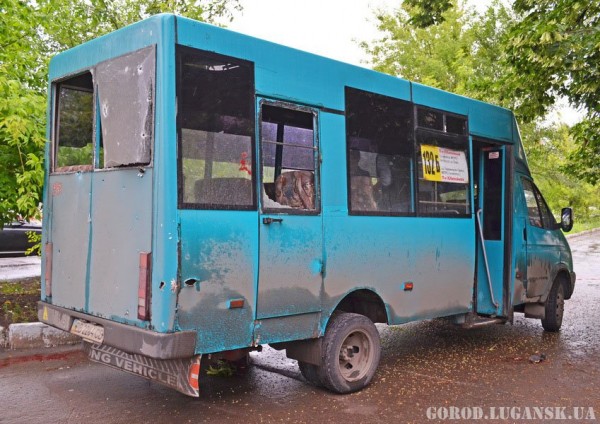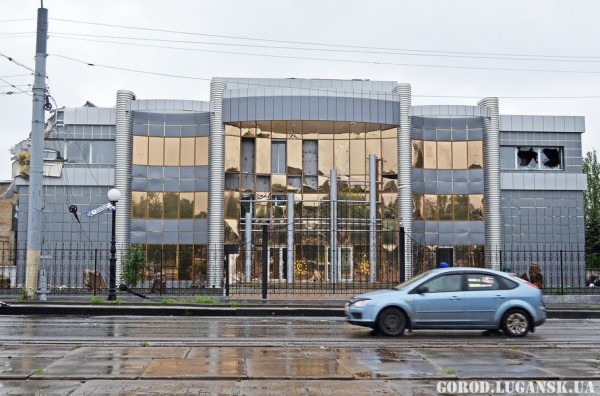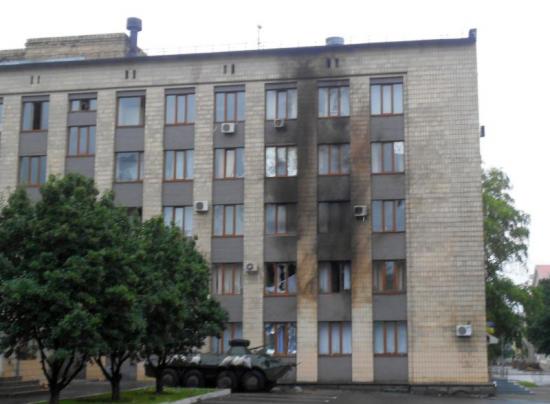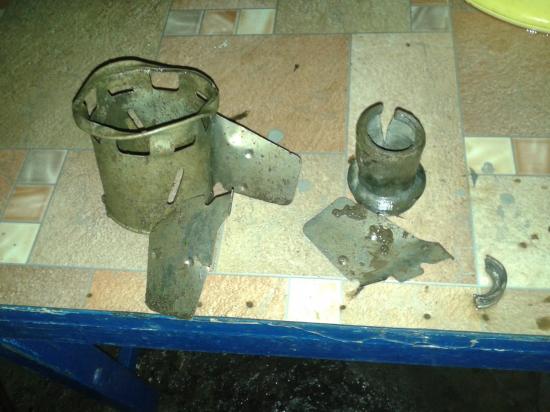Yesterday’s liveblog can be found here. For an overview and analysis of this developing story see our latest podcast.
Please help The Interpreter to continue providing this valuable information service by making a donation towards our costs.
View Ukraine: April, 2014 in a larger map
For links to individual updates click on the timestamps.
Below we will be making regular updates so check back often.
Vladimir Putin may have had a very good year in 2013, but the reality is that by the time the crisis broke out in Ukraine Russia’s economy was struggling, the opposition movement was resurgent, and the good press that was supposed to accompany the Sochi 2014 Winter Olympics was fading as news of corruption on an incredible scale was taking center stage.
The annexation of Crimea changed the narrative. Putin’s approval ratings soared, as did national pride. But The Interpreter’s Andrew Bowen, writing for The Moscow Times, writes that ultimately Crimea will prove to be Putin’s undoing.
Now Putin’s praetorians are beginning to attack each other in their search for new targets. Accusations, investigations, charges and even the odd police general jumping out a window are signs of increasingly cannibalistic competition among the myriad of Russian security agencies.
Crimea has also dashed the hope that Russia would support entrepreneurship over continued reliance on natural resources. State monopolies and the oil and gas sector are to remain the champions of the economy as sanctions sap investors’ confidence in Russia. Ukraine’s crisis, taken alongside Putin’s repressive politics, has also led to the emigration of the intellectuals and entrepreneurs needed to propel Russia’s economy.
This threatens more than simple growth projections — it threatens the implicit agreement which has allowed Putin to stay in power so long. Putin is allowed to rule, even in an increasingly authoritarian way, as long as stability and the standards of living rise. That agreement is under threat as the economy shifts from a free market to an oligopoly, with only a few sectors propelling the economy.
Two statues of Lenin were toppled last night in Ukraine.
One of the statues of the leader of the Bolshevik revolution, and a symbol of the brutal communist oppression of Ukraine, was torn down in the village of Chervona Sloboda in the northern Sumy region.
Interfax-Ukraine reports that the Ukrainian Communist Party has confirmed the removal of the statue and is pursuing criminal charges:
“Law enforcers have established that vandals damaged the monument by having it pulled down from the pedestal by a tractor and a tow,” the statement said.
The monument is on the balance-sheet of the local rural council, the spokesperson said.
“A criminal case has been opened over the act of vandalism,” the party said.
Another statue was torn down in the town of Bilozerka in the southern Kherson region.
Tipichny Kherson, a local news site, reported (translated by The Interpreter):
Tired of waiting for the authorities’ decision, Ukrainian activists came to Bilozerka and dismantled the monument to Lenin by themselves. The police did not interfere with the will of the people.
Here are some photos from the felling of the statue:
However, in Kramatorsk, recently liberated by Ukrainian forces, an attempt by activists to tear down a statue of Lenin was prevented by Ukrainian soldiers.
Ukrainian television station TSN reports that several dozen activists arrived following discussions on social media but were blocked by soldiers and an armoured personnel carrier. It appears that the Ukrainian military are wary of any possible provocation in the recently retaken town.
Ukrainska Pravda reports on a reported attack on a mine in the Petrovsky district outside Donetsk.
The administrative building for mines 4-21 was occupied by separatists from the self-declared ‘Donetsk People’s Republic’ on June 19. The site is 100 metres from the mining buildings.
Municipalnaya Gazeta, a local news source had reported that the strike was preceded by the appearance of a Ukrainian military aircraft.
But Olexei Dmitrashkovsky, a press officer for the Ukrainian government’s Anti-Terrorism Operation, told Ukrainska Pravda that no aircraft was flying near Donetsk today.
However he was unable to comment on whether Ukrainian security forces were carrying out any operations in the area of the mine, which leaves room for a possible artillery strike.
An Ukrainska Pravda correspondent at the scene reported that there were no casualties following the blasts.
Their report includes photos of what their reporter was told was shrapnel from the blasts.



Interfax-Ukraine reports that the Ukrainian President, Petro Poroshenko, has called for the UK and Italy to join the peace talk group known as the ‘Normandy Four’ which currently includes Ukraine, Russia, Germany and France.
Commenting on President Poroshenko’s discussions with the Italian foreign minister, Federica Mogherini, the Ukrainian president’s press service said:
“The president praised the efforts of Germany and France, which allowed the formation of the so-called “Normandy four” [Ukraine, Russia, Germany and France] with the participation of Russia. Still, according to him, the international influence could be much stronger if Italy and Britain joined France and Germany.”
The Italian foreign minister was also reportedly supportive of Ukraine’s efforts to resolve the crisis:
“We support your peace plan. We will use all our influence and all our opportunities, including bilateral contacts, to achieve the settlement in the region,” Poroshenko’s press service quoted Mogherini as saying.
“We feel the challenges that arise not only in Ukraine, but also in the EU-Russian relations,” the Italian foreign minister said.
The Russian MICEX is higher than it has been at any point in the last 9 months. Bloomberg reports:
The Micex has rallied 24 percent from this year’s trough on March 14, the last trading day before Crimea’s referendum on joining Russia. Ukraine’s army achieved the biggest victories of a three-month campaign in the past few days, retaking the towns of Slovyansk and Kramatorsk. Pro-Russian rebels have fled to Donetsk and Luhansk, where they’ve vowed to make a stand.
Today’s advance is “a reaction to Russia not trying to intervene in the events in south-east Ukraine,” Vadim Bit-Avragim, who helps oversee about $4.1 billion at Kapital Asset Management LLC in Moscow, said by e-mail. “Everybody was afraid of Russia intervening and now it’s clear that there won’t be any further participation.”
Representatives of the 28 European Union governments met in Brussels yesterday and agreed sanctions could be applied as soon as tomorrow to more Russian individuals they accuse of backing the insurgency.
“It looks like sanctions aren’t scaring anyone anymore,” Bit-Avragim said.
Russia’s economy is still fairly stagnant, but investors have now completely corrected for the lower stock values that were the direct result of the crisis in Ukraine.
The long-term implications for the Russian economy, however, are as bleak as ever, and the proof of that is Russia’s energy giant Gazprom. Again, Bloomberg reports:
ADRs (OGZPY) of Gazprom, the world’s largest natural-gas producer, dropped to $8.82 yesterday, a 1.2 percent decline from the previous close on July 3 and the biggest retreat since June 4. The stock advanced in Moscow for a second day, rising 1.9 percent to 153.18 rubles at 1:52 p.m. in the Russian capital.
The aggregate dividend forecast for state-controlled companies in 2016 may be reduced by 80 percent, including a 32 percent decrease for Gazprom, according to Finance Ministry estimates. The plan coincides with a slowdown in the Russian economy just as U.S. and European sanctions against President Vladimir Putin for his annexation of Crimea hurt output.
This is “the reality of a more difficult economic and corporate environment,” David Riedel, president and founder of Riedel Research Group Inc. in New York, said by e-mail yesterday. “Lower energy prices, falling economic growth and the business impact of uncertainty caused by the Russia-Ukraine conflict are clearly hurting corporate performance and thus dividend and other payouts.”
Gazprom’s problems are ultimately Russia’s problems, as Russia relies heavily on the energy sector. But many of the problems in the Russian economy actually predate this current crisis. The bigger picture is that Russia is reliant on high energy prices and protectionist policies, and that strategy is not working.
But there are also two key myths that are easily debunked by looking at the data. The first is the idea that sanctions are having a significant impact on the Russian economy. They are not. The weakness in the economy predates and is largely unrelated to sanctions. The second myth is that just because the Russian markets have rallied means that there is no long-term consequence to the Russian stocks being in the lurch for months. The bottom line is that the instability, much more than the sanctions, did leave wounds in the Russian economy, and that will have consequences for future growth — as well as for Russian tax revenue.
Valery Bolotov, the leader of the self-declared Lugansk People’s Republic (LNR), has stated at a press conference today that his separatist forces are in control of the Izvarino area and the section of the Russo-Ukrainian border it lies on.
He claimed that LNR forces had succeeded in pushing back Ukrainian forces from Lugansk, noting that “some sections of the front line have moved in our favour.”
He also claimed that the LNR militia had acquired significant military hardware, though did not specify where from (though their claim to control a border crossing certainly suggests Russian imports).
Bolotov said that his forces now had “armoured vehicles and artillery systems” including Grad rocket launchers, howitzers, anti-aircraft systems and mortars.
He also claimed that while the LNR was prepared for peace talks, they would only do so under their own terms, accusing the Ukrainian government of using the ceasefire to concentrate their forces.
Russian-backed separatists have withdrawn from Slavyansk to Donetsk and the Kramatorsk/Lugansk area. Donetsk, however, is Ukraine’s 5th largest city, and the civilian populace is making it very difficult to fight a war. This is by design. The separatists who spoke with Svoboda’s Andrei Babitsky told him that they planned to burrow deeply into the city, effectively using the populace as human shields.
This problem, combined with the guerrilla tactics of the separatist fighters in the area, is increasing tension. And that tension appears to be showing, at least at some of the checkpoints leading into the city.
Novosti Donbassa reports that the mayor of Donetsk, Oleksandr Lukyanchenko, announced at a press conference today that militants from the self-declared Donetsk People’s Republic have kidnapped the directors of two mines.
The directors of the A.A. Skochinsky and the Kalinina mines were abducted this morning from their places of work. After the press conference Lukyanchenko said that talks were under way to secure their release.
The article names the director of the Skochinsky mine as Varlam Valerianovich Miminoshvili.
The Lugansk City Council website reports that two people were killed this morning when a marshrutka (a fixed-route minibus taxi) was struck by shrapnel from a shell.
The announcement says (translated by The Interpreter):
Today, July 8 at 7:50, two people were killed and four wounded on the number 132 marshrutka by shrapnel from a shell in the Proletariat of Donbass neighbourhood. The wounded have been taken to medical centres.
Residents are kindly requested to avoid non-urgent travel through the city, and to avoid sites of armed confrontations.
The mayor of Lugansk, Sergei Kravchenko, visited the site and appealed for both sides to cease fire and for peace to return to the area:
No suggestion has been made as yet as to which side is responsible for the shelling.
The city council website also uploaded photos from the scene, including evidence of wider damage to parked buses and other buildings:



Vecherny Bakhmut, an Artyomovsk-based news site, reports that the town council building was struck last night by a shoulder-launched missile.
They report (translated by The Interpreter):
A powerful explosion rang out at 3 am in the centre of Artyomovsk.
The explosion was preceded by several shots, which sounded as if they came from a heavy machine gun. Then the sky was lit up by a bright flash and a tremendous rumble was heard. Numerous car alarms went off in the town centre. The expected shoot out did not follow. Only 10-15 minutes later came a few shots from automatic weapons.
What exactly had exploded and where – became clear in the morning. The town council building had been fired on with a ‘Shmel‘ infantry flamethrower from the car park. The blast occurred on the exterior of the building at the level of the second floor, near the office where the archives of the decisions of the executive committee and the sessions of the city council are stored. A small fire arose, which was extinguished. The archive was not damaged. Many windows were knocked out inn the town council building and neighbouring houses.

A soldier from the Interior Ministry’s Artyomovsk special battalion sustained light injuries. It is most likely that the attack was committed by a sabotage and intelligence group from the DNR [Donetsk People’s Republic], but this report has not been confirmed.
Another explosions occurred in a residential area near Kozachenko and May 9 streets. Local residents took photos of the remains of an RPO Shmel collected from a garden, and posted them on social networks.

Allegedly, a sabotage group had fired on one of the hostels where personnel from the Artyomovsk battalion are staying, but missed and struck the garden of a private house. There were no casualties, only broken windows.
Photos: Dmitry Lyubimov and social networks.
The shell fragments do appear to resemble the ammunition of the RPO Shmel weapon.
 [Photo from wikipedia]
[Photo from wikipedia]
The blast effects also resemble those of the themobaric variant of the missile (the report describes the weapon as a flamethrower which, while inaccurate, is a common description of this weapon). While the RPO-A Shmel themobaric weapon can be devastating as demonstrated by the video below showing its use by Russian forces in Dagestan (around 39 seconds in), it produces a largely ineffectual flash-blast if detonated outdoors, as it depends on the surrounding air for oxidising its explosive payload.
Ukrainska Pravda reports that Valeriy Heletey, the new Ukrainian defence minister, has announced that there will be no further one-sided ceasefires.
They report, (translated by The Interpreter):
“The President has spoken about this unequivocally. Any negotiations are now only possible once the militants finally lay down their arms,” he stressed.
“An active phase of the ATO is under way. We are doing everything possible to minimise the number of casualties. The military wants peace. The militants must lay down their arms,” added Heletey in comments to Ukrainska Pravda.
In addition, Heletey said that many roads were now mined by the terrorists. The affected routes are from Slavyansk to Kramatorsk and Slavyansk to Artyomovsk.
“There are a lot of mines and unexploded shells lying right on the roadside and the road surface. There is the possibility that they could be detonated, so we are taking measures to clear and dispose of these mines and shells as quickly as possible. For this purpose, the appropriate units are working almost around the clock,” said Heletey.
He also categorically denied media reports of the alleged captured of an Su-25 aircraft by the terrorists.